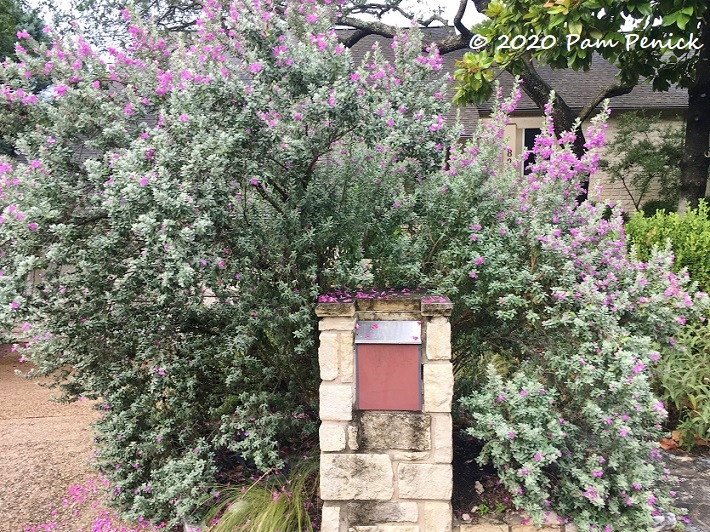Key Takeaways
Texas Sage is non-toxic to both dogs and cats, making it a safe choice for pet-friendly gardens.
This hardy shrub thrives in full sun and well-drained soil, requiring minimal maintenance once established.
Texas Sage is a magnet for bees and other pollinators, enhancing biodiversity in your garden.
Its ornamental appeal includes vibrant flowers and silvery foliage, adding visual interest year-round.
Being drought-resistant, Texas Sage is ideal for xeriscaping and sustainable gardening practices.
Texas Sage in Your Pet-Safe Garden: Benefits, Safety, and Benefits to Wildlife
Introduction to Texas Sage
Texas Sage, also known as Leucophyllum frutescens, is a versatile and attractive shrub that fits beautifully into a pet-safe garden. This evergreen plant is cherished for its stunning blooms and hardy nature. But what truly sets Texas Sage apart is its non-toxicity to pets, making it an excellent choice for those who want a beautiful garden without compromising their furry friends’ safety.
Let’s dive deeper into why Texas Sage is a fantastic addition to your garden and how it benefits both your pets and local wildlife.
“Cenizo in bloom after the rain – Digging” from www.penick.net and used with no modifications.
Texas Sage Overview
Native to the southwestern United States and Mexico, Texas Sage thrives in hot, arid climates. This plant is well-suited for USDA hardiness zones 8 through 11, which means it can handle a range of temperatures but performs best in warmer regions.
Texas Sage Characteristics
Texas Sage is known for its silvery-gray foliage and vibrant flowers that can range from purple to pink. These blooms typically appear after a rainfall, adding a burst of color to your garden. The shrub can grow up to 5 feet tall and wide, making it a substantial addition to any landscape.
Here are some key characteristics of Texas Sage: it is a hardy plant that can withstand tough conditions, making it a great addition to your garden. Additionally, Texas Sage is pet-safe, ensuring that your furry friends can roam around without any risk of toxicity.
Height/Spread: 2 to 5 feet tall and wide
Bloom Time: June to October
Bloom Color: Purple, pink, or white
Exposure: Full sun
Water Needs: Low, drought-tolerant once established
Benefits of Texas Sage in a Pet-Safe Garden
Besides its visual appeal, Texas Sage offers several benefits that make it a valuable addition to your garden, especially if you have pets. Let’s explore these advantages in more detail.
Ornamental Appeal
One of the primary reasons gardeners love Texas Sage is its ornamental value. The shrub’s silvery foliage provides a beautiful contrast to its vibrant flowers, creating a striking visual effect. Whether used as a hedge, a border plant, or a standalone specimen, Texas Sage enhances the aesthetic appeal of any garden.
Low Maintenance
Texas Sage is incredibly low maintenance, making it perfect for busy gardeners or those new to gardening. Once established, it requires minimal watering and can thrive in poor soil conditions. This resilience means you can spend less time worrying about plant care and more time enjoying your garden.
Durability in Different Climates
Another significant advantage of Texas Sage is its ability to withstand various climate conditions. It is particularly well-suited for hot, dry climates but can also tolerate occasional cold snaps. This adaptability makes it a reliable choice for gardeners in diverse regions.
“Bees on Weeds — Rancho Incognito” from www.ranchoincognito.com and used with no modifications.
Attraction to Bees and Pollinators
Texas Sage is a magnet for bees, butterflies, and other pollinators. Its flowers provide a valuable nectar source, helping to support local wildlife populations. By planting Texas Sage, you’re not only beautifying your garden but also contributing to the health of your local ecosystem.
Texas Sage Safety for Pets
When it comes to creating a pet-safe garden, one of the primary concerns is ensuring that the plants you choose are non-toxic to your furry companions. Texas Sage shines in this regard, offering beauty and safety in one package.
Non-Toxic to Dogs
One of the most reassuring aspects of Texas Sage is its non-toxicity to dogs. According to the ASPCA, Texas Sage is not listed as a toxic plant for dogs. This means you can plant it in your garden without worrying about your dog getting sick if they decide to have a nibble.
Impact on Cats
Just like with dogs, Texas Sage is also safe for cats. Cats are often more curious about plants than dogs, and they might chew on leaves or flowers. Fortunately, Texas Sage poses no harm to your feline friends. This makes it a versatile and safe choice for households with multiple types of pets.
Precautions to Take
While Texas Sage is generally safe, it’s always a good idea to take some precautions. Here are a few tips to ensure your pets stay safe: consider incorporating pet-safe evergreen shrubs that can withstand dog urine in your garden.
Supervise Initial Interactions: When you first introduce Texas Sage to your garden, keep an eye on your pets to see how they interact with the plant.
Regular Maintenance: Keep the plant well-maintained by pruning dead or decaying parts, which could harbor mold or pests that might be harmful.
Placement: Plant Texas Sage in areas where pets don’t frequently dig or play to prevent any accidental uprooting.
Planting and Care Tips
Now that we know Texas Sage is safe for pets, let’s discuss how to plant and care for it to ensure it thrives in your garden. Proper planting and care will help you get the most out of this beautiful shrub.
Choosing the Right Location
The first step in planting Texas Sage is selecting the right location. This shrub loves full sun and well-drained soil, so choose a spot in your garden that meets these criteria.
Soil Requirements
Texas Sage is not picky about soil types, but it does best in well-drained soil. If your garden soil is heavy or clay-like, consider amending it with sand or gravel to improve drainage. Poor drainage can lead to root rot, which is detrimental to the plant’s health.
Here’s a simple way to check if your soil is well-drained:
Dig a hole about 12 inches deep and fill it with water.
Let it drain completely, then fill it with water again.
If the water drains within 24 hours, your soil is well-drained. If not, consider amending it.
Optimal Sun Exposure
Texas Sage thrives in full sun, which means it needs at least 6 to 8 hours of direct sunlight each day. Planting it in a sunny spot will ensure robust growth and vibrant blooms. If you live in a particularly hot climate, a little afternoon shade can help protect the plant from scorching.
Maintenance Tips
Once planted, Texas Sage requires minimal maintenance. However, a few care tips can help keep your plant healthy and looking its best. For pet owners, it’s also worth considering pet-safe evergreen shrubs that can withstand dog urine.
Watering Needs
Texas Sage is drought-tolerant once established, which means it doesn’t need frequent watering. Overwatering can actually harm the plant, so it’s better to err on the side of underwatering. Water the plant deeply but infrequently, allowing the soil to dry out between waterings.
Pruning Guidelines
Regular pruning helps maintain the shape of the Texas Sage and encourages new growth. Prune the plant after it blooms to remove spent flowers and any dead or damaged branches. This will help keep the shrub looking tidy and promote a healthy growth cycle.
Here are some pruning tips:
Use sharp, clean pruning shears to avoid damaging the plant.
Remove any dead or diseased branches first.
Trim back about one-third of the plant’s overall size to encourage new growth.
Overwatering Risks
While Texas Sage is a hardy and resilient plant, overwatering can be a significant issue. Excessive moisture can lead to root rot, which is detrimental to the plant’s health. Root rot occurs when the roots are constantly wet, depriving them of the oxygen they need to thrive. For more tips on maintaining a pet-friendly garden, check out pet-safe evergreen shrubs.
To avoid overwatering, follow these guidelines:
Water deeply but infrequently, allowing the soil to dry out between waterings.
Ensure the planting area has good drainage to prevent water from pooling around the roots.
During rainy seasons, reduce or eliminate supplemental watering to avoid excess moisture.
Dealing with Pests
Texas Sage is generally resistant to most pests, but occasional issues can still arise. Common pests include spider mites and aphids. These pests can cause damage by sucking the sap from the plant, leading to weakened growth and discolored leaves.
Here are some natural remedies to deal with these pests:
Spider Mites: Spray the plant with a strong stream of water to dislodge the mites. You can also use insecticidal soap or neem oil as a natural pesticide.
Aphids: Introduce beneficial insects like ladybugs to your garden, which feed on aphids. Alternatively, use a mixture of water and mild dish soap to spray the affected areas.
Conclusion
Texas Sage is an excellent addition to any pet-safe garden, offering beauty, resilience, and safety for your furry friends. Its non-toxic nature, combined with its low maintenance requirements and ability to attract pollinators, makes it a valuable plant for any garden enthusiast.
Summary of Benefits and Safety
To summarize, Texas Sage is non-toxic to both dogs and cats, making it a safe choice for pet-friendly gardens. It thrives in full sun and well-drained soil, requiring minimal maintenance once established. The plant attracts bees and other pollinators, enhancing biodiversity in your garden. Its ornamental appeal includes vibrant flowers and silvery foliage, adding visual interest year-round. Lastly, being drought-resistant, Texas Sage is ideal for xeriscaping and sustainable gardening practices.
Frequently Asked Questions (FAQ)
Is Texas Sage actually safe for my pets?
Yes, Texas Sage is non-toxic to both dogs and cats, making it a safe plant for your pet-friendly garden.
How often should I water Texas Sage?
Water Texas Sage deeply but infrequently, allowing the soil to dry out between waterings. Overwatering can lead to root rot, so it’s better to underwater than overwater.
Will Texas Sage attract bees and other pollinators?
Yes, Texas Sage is known to attract bees, butterflies, and other pollinators, making it a great plant for enhancing local biodiversity. Additionally, it’s important to note that pet-safe plants like Angelonia can also contribute to a thriving garden without posing a risk to your pets.
Can Texas Sage grow in shaded areas?
Texas Sage thrives best in full sun, requiring at least 6 to 8 hours of direct sunlight each day. While it can tolerate some shade, it may not bloom as profusely in shaded areas.
In conclusion, Texas Sage is a versatile and beautiful addition to any pet-safe garden. Its benefits far outweigh any minor challenges, making it a must-have for garden enthusiasts looking to create a safe and vibrant outdoor space.
Texas sage is a popular choice for pet-safe gardens because it is non-toxic to dogs and cats. This hardy plant is also known for attracting bees, making it a great addition to any garden looking to support local pollinators. While it is generally safe, it’s always a good idea to monitor your pets to ensure they don’t overindulge in any plant material. For more information on pet-friendly plants, you can check out Sweet Alyssum, another great option for your garden.







